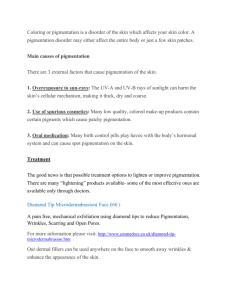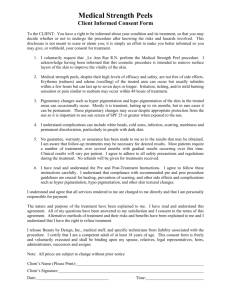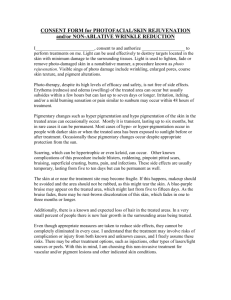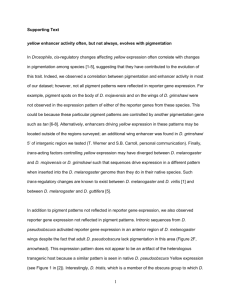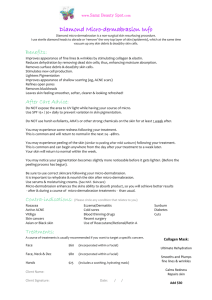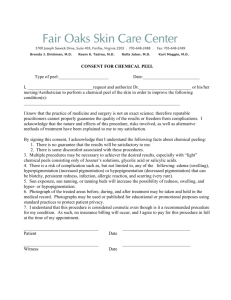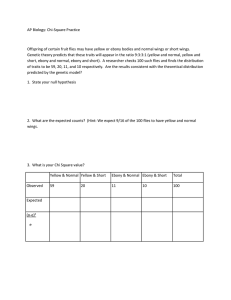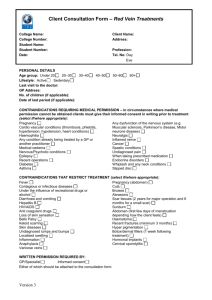The molecular genetics of clinal variation: a case study of
advertisement
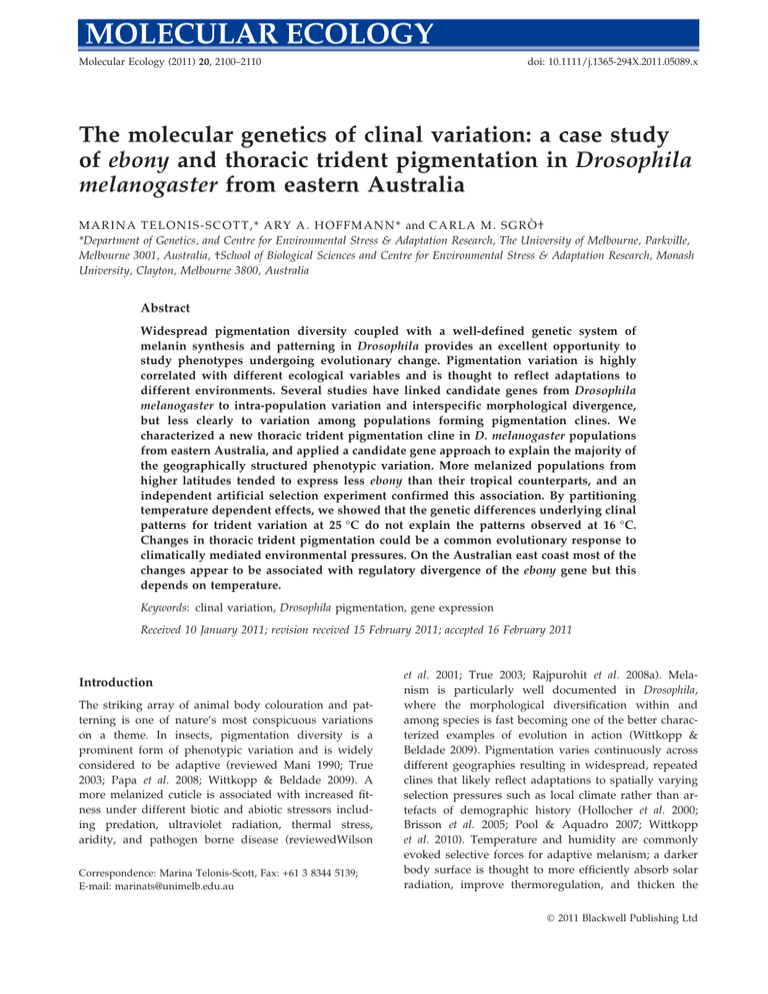
Molecular Ecology (2011) 20, 2100–2110 doi: 10.1111/j.1365-294X.2011.05089.x The molecular genetics of clinal variation: a case study of ebony and thoracic trident pigmentation in Drosophila melanogaster from eastern Australia M A R I N A T E L O N I S - S C O T T , * A R Y A . H O F F M A N N * and C A R L A M . S G R Ò † *Department of Genetics, and Centre for Environmental Stress & Adaptation Research, The University of Melbourne, Parkville, Melbourne 3001, Australia, †School of Biological Sciences and Centre for Environmental Stress & Adaptation Research, Monash University, Clayton, Melbourne 3800, Australia Abstract Widespread pigmentation diversity coupled with a well-defined genetic system of melanin synthesis and patterning in Drosophila provides an excellent opportunity to study phenotypes undergoing evolutionary change. Pigmentation variation is highly correlated with different ecological variables and is thought to reflect adaptations to different environments. Several studies have linked candidate genes from Drosophila melanogaster to intra-population variation and interspecific morphological divergence, but less clearly to variation among populations forming pigmentation clines. We characterized a new thoracic trident pigmentation cline in D. melanogaster populations from eastern Australia, and applied a candidate gene approach to explain the majority of the geographically structured phenotypic variation. More melanized populations from higher latitudes tended to express less ebony than their tropical counterparts, and an independent artificial selection experiment confirmed this association. By partitioning temperature dependent effects, we showed that the genetic differences underlying clinal patterns for trident variation at 25 C do not explain the patterns observed at 16 C. Changes in thoracic trident pigmentation could be a common evolutionary response to climatically mediated environmental pressures. On the Australian east coast most of the changes appear to be associated with regulatory divergence of the ebony gene but this depends on temperature. Keywords: clinal variation, Drosophila pigmentation, gene expression Received 10 January 2011; revision received 15 February 2011; accepted 16 February 2011 Introduction The striking array of animal body colouration and patterning is one of nature’s most conspicuous variations on a theme. In insects, pigmentation diversity is a prominent form of phenotypic variation and is widely considered to be adaptive (reviewed Mani 1990; True 2003; Papa et al. 2008; Wittkopp & Beldade 2009). A more melanized cuticle is associated with increased fitness under different biotic and abiotic stressors including predation, ultraviolet radiation, thermal stress, aridity, and pathogen borne disease (reviewedWilson Correspondence: Marina Telonis-Scott, Fax: +61 3 8344 5139; E-mail: marinats@unimelb.edu.au et al. 2001; True 2003; Rajpurohit et al. 2008a). Melanism is particularly well documented in Drosophila, where the morphological diversification within and among species is fast becoming one of the better characterized examples of evolution in action (Wittkopp & Beldade 2009). Pigmentation varies continuously across different geographies resulting in widespread, repeated clines that likely reflect adaptations to spatially varying selection pressures such as local climate rather than artefacts of demographic history (Hollocher et al. 2000; Brisson et al. 2005; Pool & Aquadro 2007; Wittkopp et al. 2010). Temperature and humidity are commonly evoked selective forces for adaptive melanism; a darker body surface is thought to more efficiently absorb solar radiation, improve thermoregulation, and thicken the 2011 Blackwell Publishing Ltd G E N E T I C S O F C L I N A L P I G M E N T A T I O N I N D R O S O P H I L A 2101 cuticle to stem water loss under low humidity (reviewed True 2003; Clusella Trullas et al. 2007; Rajpurohit et al. 2008a). Darker abdominal pigmentation correlates strongly with altitude in Drosophila melanogaster from sub-Sahara Africa (Pool & Aquadro 2007), and forms parallel clines with desiccation resistance at high latitude and altitude on the Indian subcontinent (Parkash et al. 2008a,c; Rajpurohit et al. 2008b). Abdominal pigmentation varies by habitat in D. polymorpha, where darker, more desiccation tolerant flies were associated with a warm, arid environment (Brisson et al. 2005). In contrast to D. melanogaster, the darkest abdomens in species from the dunni subgroup along a latitudinal cline were recorded closest to the equator, where species differentiation is likely shaped by complex natural and sexual selection (Hollocher et al. 2000). The cline for body colour in D. americana deviates from a latitudinal association to a longitudinal one, and is correlated with relative humidity but not desiccation tolerance (Wittkopp et al. 2010). The thermal melanism hypothesis may better explain patterns of local adaption in this species, as darker individuals tend to occur in areas with lower temperatures and solar radiation (Clusella Trullas et al. 2007; Clusella-Trullas & Terblanche 2010). Drosophila pigmentation variation is due to the differential localization and abundance of black, yellow and brown pigments determined by the expression of core structural genes including yellow, ebony and tan, first identified in D. melanogaster (reviewed True 2003; Wittkopp et al. 2003; Wittkopp & Beldade 2009). The yellow and ebony genes have opposite effects on integument colour: yellow protein converts dopa to black dopa melanin while the ebony protein converts dopamine to N-balanyl dopamine (NBAD) to form yellowish sclerotin and can suppress the action of yellow in forming black pigmentation (Wittkopp et al. 2002a). Brown pigment is produced by converting NBAD back to dopamine in a reverse reaction by an NBAD hydrolase encoded by tan (True et al. 2005). Polymorphisms affecting the function of these genes are obvious candidates for intra- and interspecific divergence (Wittkopp et al. 2002b, 2009; Jeong et al. 2008; Rebeiz et al. 2009). The yellow protein is spatiotemporally distributed to all cells with black pigment and is dependent on tan activity to form black melanin, and both genes contribute to divergent pigmentation patterns among Drosophila species (Wittkopp et al. 2002a,b, 2009; Jeong et al. 2008). A loss of function of ebony is also highly associated with melanism within and between species including abdominal pigmentation in D. melanogaster and body colour differences between sister species D. novomexicana and D. americana (Pool & Aquadro 2007; Rebeiz et al. 2009; Wittkopp et al. 2009). In addition to the genetic differences underlying pigmentation variation, Drosophila populations exhibit a 2011 Blackwell Publishing Ltd range of reaction norms for pigmentation in response to developmental temperature (David et al. 1985, 1990; Gibert et al. 2000). Repression of pigmentation enzymes such as ebony underlie phenotypic plasticity for abdominal pigmentation in D. melanogaster, but at low temperatures these regulatory changes are modulated by different mechanisms (Gibert et al. 2007; Rebeiz et al. 2009). Low ebony expression also correlates with another pigmentation polymorphism, the intensity of a ‘trident’ shaped melanic pattern on the thorax. Wittkopp et al. (2002a) showed that ebony mutants exhibit an extreme black trident pattern (with some yellow protein present), while double ebony ⁄ yellow mutants express a trident comprised of brown pigments. In D. melanogaster, while ebony mRNA is present throughout development and in young adults (Hovemann et al. 1998), expression levels in non-pigmented thoraces are highest in the cells that form the trident in ebony mutants and transformants (Wittkopp et al. 2002a; Gibert et al. 2007). Takahashi et al. (2007) mapped trident intensity differences to the ebony locus in two field-derived inbred lines, where reduced expression was responsible for the trident pattern in a Taiwanese line compared to a non-melanized African line. Studies of natural populations suggest that, like abdominal melanism, thoracic trident pigmentation is a highly plastic and likely adaptive trait. In D. melanogaster, David et al. (1985) observed a steep transcontinental cline of increasing trident pigmentation between 30 and 50 latitude, coinciding with cooler temperate climates. Similarly to abdominal pigmentation, multiple ecological variables contribute to trident variation in India (Munjal et al. 1997; Parkash & Munjal 1999), where over 90% of D. melanogaster thoracic trident variation could be predicted by both latitude and altitude (Munjal et al. 1997). Cross-species clines further support the adaptive significance of thoracic trident variation; D. simulans exhibits a cryptic latitudinal cline despite reduced geographic variation compared to its sibling species D. melanogaster (Capy et al. 1988). While ebony is a compelling candidate for the genetic basis of trident variation, this is largely limited to data from mutant or isogenic lines with fixed phenotypes and reduced phenotypic plasticity (Takahashi et al. 2007). The contribution of expression variation at this locus to clinally varying patterns of trident pigmentation remains unclear. To date, studies of the genetics of pigmentation diversity have mostly focused on within population or between species comparisons, while the genetic factors underlying clinal, intra-specific variation for the different pigmentation traits are largely unexplored. The present study addresses this disparity by examining the relationship between phenotypic variation for thoracic trident 2102 M . T E L O N I S - S C O T T , A . A . H O F F M A N N and C . M . S G R Ò variation and expression of the candidate gene ebony along a geographical gradient. Thoracic trident intensity is a useful pigmentation metric in D. melanogaster that is associated with similar geographic variables as abdominal pigmentation (David et al. 1985; Munjal et al. 1997). Here, we link clinally varying trident variation in nature with ebony expression variation in D. melanogaster collected from 18 sites along the east Australian coastline. We show that increasing pigmentation is positively correlated with latitude and negatively correlated with ebony expression. The ebony expression cline explained two thirds of the pigmentation variation at 25 C and latitude explained about 40% of the ebony expression variation where the genetic differences for pigmentation intensity among populations were clear. However these clines disappeared at 16 C where a plastic response to the low rearing temperature resulted in a uniformly darker trident. Our results suggest that different mechanisms may underlie these temperature-dependent plastic and genetic phenotypes. Materials and methods Drosophila melanogaster populations Australian east coast populations. Populations of D. melanogaster were collected from the Australian east coast in April–June 2008 from 18 locations ranging from Innisfail QLD (17.52S) to Sorrell TAS (43.15S) (Sgrò et al. 2010; Table S1, Supporting Information). Each experimental population was initiated from 30 isofemale lines following two generations of laboratory culture. The populations were maintained at 25 C under constant light at a population size of at least 1000 flies prior to the assays. Coffs Harbour mass breds and pigmentation selected lines. For the ebony association study, an independent population from the midpoint of the east coast transect (Coffs Harbour, NSW, 30.37S) was collected in January 2010. Briefly, 60 females were brought into the laboratory and a mass bred population was established by pooling 10 male and 10 virgin female F1 progeny from each isofemale line derived from the field females (1200 flies). The mass bred population was allowed to freely recombine at a population size of at least 1000 flies until the experiment was initiated at F7 generation of laboratory culture. For the experiment, flies were reared at 25 C as described above. Light and dark trident lines were established by selecting the 20 lightest and 20 darkest flies from 400 F7 Coffs Harbour mass bred females. This was repeated three times, resulting in three ‘light’ lines and three ‘dark’ lines. In addition, two lines representing the ends of the Australian east coast clinal distribution with darkest phenotype (Sth Tasmania) and lightest phenotype (Innisfail, QLD) were also selected at a lower intensity, where the 20 lightest and 20 darkest flies were selected from 100 females. One set of light and dark lines were established for each of these cline end populations, bringing the total number of lines selected to 10. Thoracic trident pigmentation scoring Australian east coast populations. David et al. (1985) showed that two growth temperatures (17 C and 25 C) were sufficient to characterize trident pigmentation variation in natural populations. Based on available controlled rearing environments, we chose 16 C and 25 C, given that the response curves remain similar between 16 C and 17 C (David et al. 1985). Flies for the assays were reared in temperature controlled rooms at 24 h constant light on standard dextrose medium in 500 mL glass bottles. Density was standardized for two generations prior to the assays by placing 25 mating pairs on food and leaving them to oviposit for 2 and 6 days at 25 C and 16 C respectively. Three bottles were set up for each population to obtain three replicate measurements per sex ⁄ temperature ⁄ population. Flies for phenotyping were collected within 48 h of eclosion, and then separated by sex into groups of 50 using aspiration without CO2. To ease scoring, flies were matured for 20 days after transferring to fresh food every few days. Thoracic trident pigmentation was scored by visual examination using the four phenotypic classes (David et al. 1985). Phenotypes were partitioned into the following categories: class 0 = no visible trident, class 1 = faint trident, class 2 = trident clearly marked and class 3 = dark trident. Flies were lightly anesthetized with CO2, examined under a dissecting microscope and assigned a score based on the above classes. Pigmentation was quantified as the average score of 35 flies from each population ⁄ sex ⁄ temperature combination, and population means were taken from the grand average of three scores (105 flies). In almost every case, 35 flies from each replicate were examined over 3 days by a single observer (35 · 3 replicates · 18 populations · 2 sexes · 2 temperatures = 7550 flies in total). Coffs Harbour selected lines. F1 female progeny of light and dark selected females were scored 20 days after eclosion as described above, sample sizes ranging from 15 to 100 flies, (except for CH2 (dark), n = 2) for a total of 446 flies. Ebony gene expression assays Fly rearing. Flies for the gene expression assays were reared at 16 C and 25 C as described above. Density 2011 Blackwell Publishing Ltd was controlled by allowing 25 mating pairs to oviposit in food bottles for 2 h at 25 C and overnight at 16 C. Imagos were collected within 1–)3 h post-eclosion to capture ebony expression (Wittkopp et al. 2002a; Takahashi et al. 2007). Three replicates of 10 females (Australian east coast populations) or six females (selected lines) per line were snap-frozen in liquid N2 and stored at )70 C. Thorax dissections and RNA extractions. To maintain the narrow window of eclosion to detect ebony expression among a large number of samples, thorax dissections were performed on frozen flies. Thoraces (legs and wings removed) were dissected from each line on ice under a dissecting microscope and homogenized in 500 lL TRIzol Invitrogen reagent. RNA was extracted following the manufacturer’s instructions, purified using an RNeasy mini kit (QIAGEN) and treated with TURBO DNA-free (Ambion) to remove residual genomic DNA. The RNA was quantified using the Take3 spectrophotometer (BioTek) and integrity assessed with agarose gel electrophoresis. Three separate RNA extractions were performed for each line. (three groups of 35 flies scored per combination) were examined using the model Yijkn ¼ l þ pi þ si þ tk þ psij þ ptjk þ stjk þ eijkn where Yijkn is the mean pigmentation score for population p, sex s, temperature t, and replicate n; l is the overall mean pigmentation score for population p; s is the sex effect; t is the temperature effect; ps is for population-by-sex interaction; pt is for population-by-temperature interaction; st is for sex-by-temperature interaction; and e is the error. All effects were considered fixed. A three-way interaction term of populationby-sex-by-temperature was initially fit and was not significant, and exclusion of this effect did not alter any inferences. Latitudinal pigmentation patterns were assessed via linear regressions with the overall average pigmentation scores of each population as the data points, and data were log transformed to improve the fit to a normal distribution. Ebony gene expression. The effects of population and temperature on ebony expression were examined using the model Yijn ¼ l þ pi þ tj þ pi tj þ eijn cDNA synthesis and real-time PCR. cDNA was synthesized from 500 ng total RNA using the following protocol in a 20 lL reaction volume: 2 lL 50 lM oligo-dT primer and 4 lL 2.5 mM dNTPs were heated to 80 C for 5 min then cooled on ice. 2 lL 10 · M-MuLV buffer and 1 lL M-Mulv Reverse Transcriptase 200 U ⁄ lL was added and the samples were incubated at 42 C for 60 min, then the enzyme was deactivated at 90 C for 10 min. The cDNA was diluted 1:10 in water. Real-time PCR was performed on the LightCycler 480 (Roche) using SYBR Green in a 2X universal buffer containing the following: 50 mM MgCl2, 10 · Immolase Buffer, 2 · Roche High Resolution Melt, 25 mM dNTPs, Immolase Taq 5 U ⁄ lL. A typical 10 lL PCR reaction contained 5 lL universal buffer, 4 lL 1 lM primer mix and 1 lL cDNA. The ebony transcripts were amplified with the following primers, forward: CTGGAATGTGCTGGTGGAG; reverse: AGACCCTTGGGCAGGTAGTT. For each cDNA, three technical replicates were performed and ebony expression levels were normalized to RpL11. As an initial PCR control, the 25 C east coast populations were repeated and normalized to Rps20 to ensure concordant results with RpL11. Statistical analyses Australian east coast population comparisons. For the east coast population comparisons, the effects of population, sex, and temperature on thoracic trident pigmentation where Yijn is the mean normalized ebony expression relative to RpL11 for population p; temperature t and replicate n; l is the overall mean ebony expression; p is the population effect; pt is the population-by-temperature interaction; and e is the error. Patterns of pigmentation and ebony expression were related to latitude via linear regressions with the means of each population as the data points for the east coast populations and the artificially selected populations. Pigmentation data were log transformed to improve normality. All analyses were performed using SAS software version 9.2 (SAS Institute, Cary, NC, USA). Results A latitudinal cline and phenotypic plasticity for thoracic trident pigmentation in eastern Australia We assessed thoracic trident pigmentation in male and female D. melanogaster collected from 18 locations along the Australian eastern seaboard. Pigmentation was measured as an average pigmentation score from 35 individuals per population ⁄ sex ⁄ temperature combination, with all measurements repeated in triplicate. The means and standard deviations of the grand average pigmentation score of 105 individuals for the 18 populations, sexes, and two developmental temperatures (16 C and 25 The data were log transformed to linearize the effects of population clustering and two outlying populations at 18.2S and 19.97S, although similar results were obtained regardless of whether transformed or untransformed data were considered. A three-way ANOVA showed significant differences in thoracic pigmentation between populations, sexes and growth temperatures (Table 1). Pigmentation was consistently darker across the populations when reared at 16 C (Table S1, Supporting Information; Fig. 1), although there was a significant population by temperature interaction (Table 1). While the sex term was significant, the two sexes were highly correlated at both temperatures (Pearson correlation r = 0.95, P < 0.0001 at both 25 C and 16 C, Fig. 1), and neither the sex-by-temperature nor sex-by-population interactions were significant (Table 1). Linear regressions on the grand average pigmentation score of each population showed significant latitudinal clines in both sexes and temperatures where flies were darker with increasing latitude, although this Table 1 Analysis of variance (ANOVA) on log transformed pigmentation scores in female and male D. melanogaster from the Australian east coast F d.f. Mean squares Population 17 3.54 Sex 1 0.98 Temperature 1 151.58 Population · Sex 17 0.18 Population · Temperature 17 2.25 Sex · Temperature 1 0.25 Error 156 0.13 Temperature dependent clinal expression of ebony. Next, we explored the contribution of expression variation of the candidate gene ebony to the clinal variation for trident pigmentation in the 18 east coast populations using real-time PCR. Given the strong correlation Table 2 Linear regressions testing for associations between pigmentation and latitude in females and males at 25 C and 16 C Trait Female pigmentation Male pigmentation Female pigmentation Male pigmentation P value 25.52 <0.0001 7.12 0.0084 1091.13 <0.0001 1.31 0.1897 16.21 <0.0001 1.83 0.1783 0.9 0.8 0.7 0.6 0.5 0.4 0.3 0.2 0.1 0 2.5 Male mean pigmentation R 2 = 0.904 2 1.5 R 2 = 0.907 1 0.5 0 0 0.5 1 1.5 2 2.5 Female mean pigmentation Fig. 1 Thoracic trident pigmentation is highly correlated between the sexes at both 16C (closed boxes) and 25C (open boxes). Mean pigmentation is given as the grand average score of 105 flies per population. The R2 shown is the fit of the linear regression line, actual Pearson’s correlation r = 0.95. R2 b (SE) t P value 0.52 0.10208 (0.02453) 4.16 0.0007 0.42 0.09768 (0.02863) 3.41 0.0036 0.25 0.01227 (0.00530) 2.32 0.034 0.24 0.01353 (0.00601) 2.25 0.038 (25 C) (25 C) (16 C) (16 C) Pigmentation scores are log transformed. Mean log pigmentation Source association was much weaker at 16 C (Table 2; Fig. 2a) compared to 25 C (Table 2; Fig. 2b). G E N E T I C S O F C L I N A L P I G M E N T A T I O N I N D R O S O P H I L A 2105 Table 3 Analysis of variance (ANOVA) for ebony expression at two temperatures in female D. melanogaster from the Australian east coast Source d.f. Mean squares Population 17 Temperature 1 Population · Temperature 1 Error 71 0.03 0.90 0.04 0.02 F P value 1.57 0.0959 43.08 <0.0001 1.91 0.0269 between the sexes for pigmentation, only females were used to examine gene expression patterns of the different populations. Two-way ANOVA showed no significant differences between populations in ebony expression, but a significant effect of temperature and a significant population-by-temperature interaction was evident (Table 3). At 16 C, linear regression on the population means showed no association of ebony expression and latitude (Table 4; Fig. 3a) or pigmentation (Table 4; Fig. 4a). In contrast, regression analysis revealed a significant negative association between ebony expression and latitude at 25 C (Table 4; Fig. 3b), where ebony expression decreased with increasing latitude. As expected from this clinal pattern, the phenotypic variation in pigmentation at 25 C was significantly negatively associated with variation in ebony expression, with linear regression explaining over 70% of the variation in pigmentation where lower levels of ebony correspond with a darker phenotype (Table 4; Fig. 4b). While the results were consistent between log transformed and untransformed pigmentation scores, the log transformation improved the fit of the regression line by almost 30%. Coffs Harbour association study. We independently corroborated the negative relationship between trident pigmentation and ebony expression using artificial selection for divergent pigmentation phenotypes. The selection lines were founded from three populations representing the cline midpoint (Coffs Harbour, NSW) and endpoints (Innisfail, QLD and Sth Tasmania). Selection for light and dark pigmentation for one generation resulted in three ‘dark’ and three ‘light’ lines from a newly collected population from Coffs Harbour (collected in 2010), and one dark and light line each from Innisfail and Sth Tasmania (collected in 2008) for a total of five dark and five light lines. The more recently field derived Coffs Harbour population had levels of pigmentation that were comparable to the earlier collection (mean pigmentation score ± SE 2008 = 0.73 ± 0.02; 2010 = 0.78 ± 0.002). One generation of selecting the 5% phenotypic extremes was sufficient to significantly alter trident pigmentation in this population (Fig. 5a, paired t-test light vs. dark; t = 9.37; d.f. = 4; P < 0.001). Innisfail flies were mostly non-melanic but did harbour genetic variation for darker pigmentation at 25 C, evident in the marked increase in trident intensity in the selected F1s, while the opposite was observed in the darkest Tasmanian population with no change in either direction (Fig. 5a). Similar to the expression data for the clinal populations at 25 C described above, regression analyses showed a significant, negative association between pigmentation and ebony expression relative to RpL11, with over 65% of the variation in pigmentation explained by a linear regression (Fig. 5b); once again, increasing pigmentation levels were associated with a strong reduction in ebony expression levels. The results were consistent between log transformed and raw pigmentation data, although the transformation improved the fit of the regression line by 20%. The darker lines always expressed less ebony than the light lines, albeit in the absence of a phenotypic shift in the dark Tasmanian line, while the largest change in ebony expression was associated with the largest phenotypic shift in the Innisfail lines. One caveat is that the cline end selected lines were included to provide contrast and were not replicated in contrast to the Coffs Harbour lines. Discussion Pigmentation diversity in Drosophila is widespread and closely associated with ecological and climatic factors, providing an ideal framework to study phenotypic Table 4 Linear regressions testing for associations between ebony expression and pigmentation or latitude at 16 C and 25 C in females from eastern Australia and from the artificial selection study at 25 C Trait 16 25 16 25 25 C C C C C pigmentation – east coast females pigmentation – east coast females latitude – east coast females latitude – east coast females pigmentation – selected females Pigmentation scores are log transformed. 2011 Blackwell Publishing Ltd R2 b (SE) 0.05 0.74 0.06 0.38 0.66 0.44660 )8.14868 0.00344 )0.00917 )17.46151 (0.45217) (1.19786) (0.00317) (0.00296) (4.43702) t P value 0.99 )6.80 1.08 )3.10 )3.94 0.3380 <0.0001 0.2945 0.0069 0.0043 ebony expression relative to RpL11 2106 M . T E L O N I S - S C O T T , A . A . H O F F M A N N and C . M . S G R Ò 0.7 Fig. 3 Temperature-dependent association of ebony expression and latitude in females at (a) 16C where there no association and (b) at 25C where there is a strong negative association. Average pigmentation scores are log transformed and linear regressions and R2 values are shown. (a) 0.6 0.5 0.4 0.3 0.2 0.1 0 15 20 25 30 35 40 45 50 45 50 ebony expression relative to RpL11 Latitude (oSouth) 0.7 (b) 0.6 0.5 0.4 0.3 R2 = 0.375 0.2 0.1 0 15 20 25 30 35 40 Latitude (oSouth) Mean log pigmentation 0.9 (a) 0.8 0.7 0.6 0.5 0.4 0.3 0.2 0.1 0 0 0.1 0.2 0.3 0.4 0.5 0.6 0.7 0.6 0.7 Fig. 4 Temperature-dependent association of ebony expression and pigmentation in females at (a) 16C where there no association and (b) at 25C where there is a strong negative association. Average pigmentation scores are log transformed and ebony expression is shown relative to the housekeeping control RpL11 in newly eclosed females. Linear regressions and R2 values are shown. Mean log pigmentation ebony expression relative to RpL11 1 (b) 0.5 0 –0.5 0 –1 –1.5 –2 –2.5 –3 –3.5 –4 –4.5 0.1 0.2 0.3 0.4 0.5 R2 = 0.7431 ebony expression relative to RpL11 variation that is shaped by natural selection. Thoracic trident pigmentation has been quantified in D. melanogaster across the world, but Australian sampling has previously been limited to two temperate populations (David et al. 1985). We investigated this trait in multiple populations sampled along the Australian east coast, where, despite evidence of recent D. melangoaster colonization, clines for numerous traits spanning a wide range of habitats have been reported, reflecting different aspects of climatic adaptation (Hoffmann & Weeks 2011 Blackwell Publishing Ltd G E N E T I C S O F C L I N A L P I G M E N T A T I O N I N D R O S O P H I L A 2107 3 (a) Mean pigmentation 2.5 2 1.5 1 0.5 0 Innisfail CH1 CH2 CH3 Sth TAS Mean log pigmentation 1.5 (b) 1 0.5 0 –0.5 –1 R 2 = 0.659 –1.5 –2 –2.5 0 0.05 0.1 0.15 0.2 0.25 ebony expression relative to RpL11 Fig. 5 Pigmentation and ebony expression respond to selection in females. (a) Mean pigmentation in five lines selected for light pigmentation (open bars) and five lines selected for dark pigmentation (closed bars). CH stands for Coffs Harbour and error bars are + SE. (b) Negative association of ebony expression and pigmentation following selection for pigmentation intensity (open markers = light selected lines, closed markers = dark selected lines, square markers = Innisfail, triangle markers = Sth Tasmania and diamond markers = Coffs Harbour lines). Average pigmentation scores are log transformed and ebony expression is shown relative to the housekeeping control RpL11 in newly eclosed females. Linear regressions and R2 values are shown. 2007). This includes morphological traits such as body size and related metrics such as thorax length (e.g. James et al. 1995; Azevedo et al. 1998; Arthur et al. 2008), life history traits related to fitness such as ovariole number and timing of egg production (Azevedo et al. 1996; Mitrovski & Hoffmann 2001) and stress adaptations such as thermotolerance (Hoffmann et al. 2002; Sgrò et al. 2010). We report that thoracic pigmentation also shows significant plastic and genetically-based clinal variation along the east coast of Australia. Consistent with earlier work (David et al. 1985; Capy et al. 1988; Munjal et al. 1997; Parkash & Munjal 1999), the darkest flies tend to 2011 Blackwell Publishing Ltd occur at higher latitudes, however differences in the strength of the clinal patterns here and between other studies are also evident. The association between latitude and pigmentation is weaker in the Australian cline, particularly at 16 C, where latitude explained just 24% of the pigmentation variation. At 25C, latitude alone explained approximately 80% of the variation from a world-wide sample (David et al. 1985), and both latitude and altitude explained over 90% of the variation in Indian populations of D. melanogaster (Munjal et al. 1997; Parkash & Munjal 1999) in contrast to an average of 47% in the current study. Local adaptation to the unique climatic conditions experienced on different continents is an obvious explanation for these differences. For example, relative humidity correlates more strongly with latitude than temperature on the Indian subcontinent, while seasonal variation provides shifting climatic patterns according to latitude that are different to seasonal patterns on other continents such as Australia and Africa (Rajpurohit et al. 2008a). The impact of different climatic selection is evident for traits such as desiccation resistance, which co-varies strongly with latitude and altitude in Indian Drosophila species but shows no such relationship in Australian populations despite clinal variation for other stress traits (Hoffmann et al. 2001; Arthur et al. 2008). The association of pigmentation intensity with survival to low humidity in Drosophila is largely supported by data collected from India, where desiccation resistance forms parallel clines with body melanization (Rajpurohit et al. 2008a). This is particularly evident along altitudinal gradients where conditions are cooler and drier (Parkash et al. 2008a,b,c). In contrast, we sampled D. melanogaster from a low elevation transect (<100 m) where geographic associations for desiccation tolerance are not apparent for either D. melanogaster or its sibling species D. simulans (Hoffmann et al. 2001; Arthur et al. 2008). This suggests that thermal adaptation is more likely to explain clinal patterns of trident pigmentation diversity along the Australian east coast. The ebony locus is located within the cosmopolitan inversion In3R(P) that also shows clinal variation in populations of D. melanogaster from eastern Australia (Umina et al. 2005). Thus, while our results strongly implicate the action of thermal selection in determining the observed clinal patterns, further work is required to determine the extent to which ebony itself is under selection, or whether the clinal patterns are a by-product of direct selection acting on the inversion. Nonetheless, our results, and those of previous studies, confirm the role of ebony in phenotypic variation in pigmentation (see below). Clinal patterns may also result from neutral processes such as genetic drift, or from population history 2108 M . T E L O N I S - S C O T T , A . A . H O F F M A N N and C . M . S G R Ò (Kawecki & Ebert 2004; Hoffmann & Weeks 2007) and it is important distinguish these factors from non-neutral processes. In the absence of spatially divergent selection, gene flow is expected to largely erode genetic differentiation for traits, thus patterns of phenotypic differentiation in populations connected by gene flow may be due to natural selection for differences in environmental conditions (reveiwed in Kawecki & Ebert 2004). Spatial genetic structure has been examined along the Australian east coast (Gockel et al. 2001; Kennington et al. 2003), and patterns of genetic variation show substantial, symmetrical gene flow following invasion of D. melanogaster over 100 years ago. While gene flow does not necessarily preclude trait differentiation due to demographic history, i.e. levels of migration may be too low or recent, migration between east coast D. melanogaster populations is extensive (Kennington et al. 2003). Despite some weak isolation by distance along the cline, Kennington et al. (2003) observed higher than expected genetic homogeneity between sites up to 500 km apart, including Tasmania and the mainland, while asymmetrical migration was rare and inconsistent with latitude. Finally, reproducible trait patterns along different environmental gradients can provide evidence of natural selection (Endler 1986). Worldwide clines, ample migration between sites, and the persistence of geographically structured phenotypic variation under common garden conditions argues strongly for a role of natural selection in the maintenance of clinal trident pigmentation variation along the Australian east coast. Elucidating the molecular targets of selection and linking these to adaptive shifts in phenotypic traits is arguably one of the biggest challenges in evolutionary biology. Here, we link ebony expression variation to thoracic trident pigmentation variation in natural populations and demonstrate that this association is temperature dependent. The strong negative association between both pigmentation and latitude and ebony expression at 25 C disappears when the developmental temperature is shifted to 16 C. This corresponds to current data for abdominal pigmentation in D. melanogaster, where different mechanisms affecting ebony expression appear to underlie genetic and plastic phenotypes. The ebony gene is a highly annotated, pleiotropic gene with major effects on pigmentation as well as other traits including photoreception and phototaxis, locomotion and reproduction (Kohn & Wittkopp 2007). Transcriptional rather than protein modifications of ebony appear to be important for adaptive pigmentation traits, where regulatory differences are mediated by modular enhancers that permit independent expression patterns in different tissues of the developing fly (Wittkopp et al. 2003). In D. melanogaster, a partial selective sweep near the cis-regulatory element (CRE) of the ebony locus was found in the darkest abdomens in African populations (Pool & Aquadro 2007) and at least five non-coding mutations in this CRE underlie adaptive abdominal melanism in a Ugandan population (Rebeiz et al. 2009). Expression variation involving ebony and tan explain pigmentation differences between closely related species D. novomexicana (derived yellow body) and D. americana (ancestral dark brown body), where fixed non-coding alleles are associated with light pigmentation but are segregating in the more variable D. americana (Wittkopp et al. 2009). At the plastic level, variation for abdominal pigmentation may be achieved by non-genetic temperature dependent mechanisms that ultimately repress pigmentation enzymes including ebony in a similar fashion to genetic differences between mutants or populations and species (Gibert et al. 2007). Gibert et al. (2007) found that temperature modulates posterior abdominal pigmentation in female D. melanogaster by regulating a chromatin regulator network which affects the regulation of pigmentation enzymes and other characters such as sex comb development in males, and suggest that phenotypic plasticity for pigmentation is a consequence of thermosensitivity of epigenetic mechanisms. While temperature dependent modulation of ebony expression appears to shape abdominal melanism in D. melanogaster, the mechanisms underlying phenotypic plasticity for trident pigmentation require further investigation. If ebony is the target pigmentation enzyme at lower temperatures where trident expression is highest, we would expect ebony expression to be lower in the trident forming cells. We did not observe this, but we did not directly quantify ebony expression levels but normalized expression to a ‘housekeeping gene’ across the entire thorax to compare large shifts in relative expression patterns between the populations at each temperature. Moreover, ebony may be temporally regulated at different developmental temperatures, and may require more detailed sampling to capture transcriptional variation. We can conclude however, that in adult flies 1–3 h old, the genetic differences that underlie the latitudinal patterns of ebony expression at 25 C do not account for the patterns observed at 16 C. Given that the heritable regulatory differences in ebony expression along the cline manifest only at 25 C, we independently confirmed that changes in ebony expression evolve in concert with a darker trident phenotype at this temperature. Nonetheless, regulatory divergence is an indirect indicator of natural selection acting at the ebony locus and the ultimate confirmation is to identify frequency shifts in causal polymorphisms along the east coast cline. The obvious next step is to focus on the ebony CRE to see if the phenotypic and expression clines are matched by allelic clines. The lack 2011 Blackwell Publishing Ltd G E N E T I C S O F C L I N A L P I G M E N T A T I O N I N D R O S O P H I L A 2109 of selection response for a light phenotype in the Tasmanian lines may be due to a history of stronger directional selection compared to the tropical populations, and it will be interesting to see if this bears out in the molecular data. In summary, while complex ecological pressures and gene-by-environment interactions make it difficult to universally explain thoracic trident pigmentation diversity, we show that on the Australian east coast, latitude and differential ebony expression account for the majority of clinal variation of a likely locally adapted phenotype. Acknowledgements We thank Belinda Van Heerwaarden and Jennifer Shirriffs for technical support and three anonymous reviewers. This work was supported by the Australian Research Council (ARC) and the Commonwealth Environment Research Facility. AAH was supported by an ARC Australian Laureate Fellowship. References Arthur AL, Weeks AR, Sgro CM (2008) Investigating latitudinal clines for life history and stress resistance traits in Drosophila simulans from eastern Australia. Journal of Evolutionary Biology, 21, 1470–1479. Azevedo RBR, French V, Partridge L (1996) Thermal evolution of egg size in Drosophila melanogaster. Evolution, 50, 2338– 2345. Azevedo RBR, James AC, McCabe J, Partridge L (1998) Latitudinal variation of wing: thorax size ratio and wing – aspect ratio in Drosophila melanogaster. Evolution, 52, 1353– 1362. Brisson JA, De Toni DC, Duncan I, Templeton AR (2005) Abdominal pigmentation variation in Drosophila polymorpha: geographic in the trait, and underlying phylogeography. Evolution, 59, 1046–1059. Capy P, David JR, Robertson A (1988) Thoracic trident pigmentation in natural populations of Drosophila simulans – a comparision with Drosophila melanogaster. Heredity, 61, 263– 268. Clusella Trullas S, van Wyk JH, Spotila JR (2007) Thermal melanism in ectotherms. Journal of Thermal Biology, 32, 235– 245. Clusella-Trullas S, Terblanche JS (2010) Local adaptation for body color in Drosophila americana: commentry on Wittkopp et al., Heredity, 2010; doi:10.1038/hdy.2010.90. Heredity Nov 10. [Epub ahead of print]. David JR, Capy P, Payant V, Tsakas S (1985) Thoracic trident pigmentation in Drosophila melanogaster – differentiation of geographical populations. Genetics Selection Evolution, 17, 211–223. David JR, Capy P, Gauthier JP (1990) Abdominal pigmentation and growth temperature in Drosophila melanogaster – similarities and differences in the norms of reaction of successive segments. Journal of Evolutionary Biology, 3, 429– 445. Endler JA (1986) Natural Selection in the Wild. Princeton University Press, Princeton, NJ. 2011 Blackwell Publishing Ltd Gibert P, Moreteau B, David JR (2000) Developmental constraints on an adaptive plasticity: reaction norms of pigmentation in adult segments of Drosophila melanogaster. Evolution & Development, 2, 249–260. Gibert JM, Peronnet F, Schlotterer C (2007) Phenotypic plasticity in Drosophila pigmentation caused by temperature sensitivity of a chromatin regulator network. Plos Genetics, 3, 266–280. Gockel J, Kennington WJ, Hoffmann A, Goldstein DB, Partridge L (2001) Nonclinality of molecular variation implicates selection in maintaining a morphological cline of Drosophila melanogaster. Genetics, 158, 319–323. Hoffmann AA, Weeks AR (2007) Climatic selection on genes and traits after a 100 year-old invasion: a critical look at the temperate–tropical clines in Drosophila melanogaster from eastern Australia. Genetica, 129, 133–147. Hoffmann AA, Hallas R, Sinclair C, Mitrovski P (2001) Levels of variation in stress resistance in Drosophila among strains, local populations, and geographic regions: patterns for desiccation, starvation, cold resistance, and associated traits. Evolution, 55, 1621–1630. Hoffmann AA, Anderson A, Hallas R (2002) Opposing clines for high and low temperature resistance in Drosophila melanogaster. Ecology Letters, 5, 614–618. Hollocher H, Hatcher JL, Dyreson EG (2000) Evolution of abdominal pigmentation differences across species in the Drosophila dunni subgroup. Evolution, 54, 2046–2056. Hovemann BT, Ryseck RP, Walldorf U et al. (1998) The Drosophila ebony gene is closely related to microbial peptide synthetases and shows specific cuticle and nervous system expression. Gene, 221, 1–9. James AC, Azevedo RBR, Partridge L (1995) Cellular basis and developmental timing in a size cline of Drosophila melanogaster. Genetics, 140, 659–666. Jeong S, Rebeiz M, Andolfatto P et al. (2008) The evolution of gene regulation underlies a morphological difference between two Drosophila sister species. Cell, 132, 783–793. Kawecki TJ, Ebert D (2004) Conceptual issues in local adaptation. Ecology Letters, 7, 1225–1241. Kennington WJ, Gockel J, Partridge L (2003) Testing for asymmetrical gene flow in a Drosophila melanogaster bodysize cline. Genetics, 165, 667–673. Kohn MH, Wittkopp PJ (2007) Annotating ebony on the fly. Molecular Ecology, 16, 2831–2833. Mani GS (1990) Theoretical models of melanism in Biston betularia – a review. Biological Journal of the Linnean Society, 39, 355–371. Mitrovski P, Hoffmann AA (2001) Postponed reproduction as an adaptation to winter conditions in Drosophila melanogaster: evidence for clinal variation under semi-natural conditions. Proceedings of the Royal Society of London Series B-Biological Sciences, 268, 2163–2168. Munjal AK, Karan D, Gibert P et al. (1997) Thoracic trident pigmentation in Drosophila melanogaster: latitudinal and altitudinal clines in Indian populations. Genetics Selection Evolution, 29, 601–610. Papa R, Martin A, Reed RD (2008) Genomic hotspots of adaptation in butterfly wing pattern evolution. Current Opinion in Genetics & Development, 18, 559–564. Parkash R, Munjal AK (1999) Phenotypic variability of thoracic pigmentation in Indian populations of Drosophila 2110 M . T E L O N I S - S C O T T , A . A . H O F F M A N N and C . M . S G R Ò melanogaster. Journal of Zoological Systematics and Evolutionary Research, 37, 133–140. Parkash R, Rajpurohit S, Ramniwas S (2008a) Changes in body melanisation and desiccation resistance in highland vs. lowland populations of D. melanogaster. Journal of Insect Physiology, 54, 1050–1056. Parkash R, Ramniwas S, Rajpurohit S, Sharma V (2008b) Variations in body melanization impact desiccation resistance in Drosophila immigrans from Western Himalayas. Journal of Zoology, 276, 219–227. Parkash R, Sharma V, Kalra B (2008c) Climatic adaptations of body melanisation in Drosophila melanogaster from Western Himalayas. Fly, 2, 111–117. Pool JE, Aquadro CF (2007) The genetic basis of adaptive pigmentation variation in Drosophila melanogaster. Molecular Ecology, 16, 2844–2851. Rajpurohit S, Parkash R, Ramniwas S (2008a) Body melanization and its adaptive role in thermoregulation and tolerance against desiccating conditions in drosophilids. Entomological Research, 38, 49–60. Rajpurohit S, Parkash R, Ramniwas S, Singh S (2008b) Variations in body melanisation, ovariole number and fecundity in highland and lowland populations of Drosophila melanogaster from the Indian subcontinent. Insect Science, 15, 553–561. Rebeiz M, Pool JE, Kassner VA, Aquadro CF, Carroll SB (2009) Stepwise modification of a modular enhancer underlies adaptation in a Drosophila population. Science, 326, 1663–1667. Sgrò CM, Overgaard J, Kristensen TN et al. (2010) A comprehensive assessment of geographic variation in heat tolerance and hardening capacity in populations of Drosophila melanogaster from eastern Australia. Journal of Evolutionary Biology, 23, 2484–2493. Takahashi A, Takahashi K, Ueda R, Takano-Shimizu T (2007) Natural variation of ebony gene controlling thoracic pigmentation in Drosophila melanogaster. Genetics, 177, 1233– 1237. True JR (2003) Insect melanism: the molecules matter. Trends in Ecology & Evolution, 18, 640–647. True JR, Yeh SD, Hovemann BT et al. (2005) Drosophila tan encodes a novel hydrolase required in pigmentation and vision. Plos Genetics, 1, 551–562. Umina PA, Weeks AR, Kearney MR, McKechnie SW, Hoffmann AA (2005) A rapid shift in a classic clinal pattern in Drosophila reflecting climate change. Science, 308, 691–693. Wilson K, Cotter SC, Reeson AF, Pell JK (2001) Melanism and disease resistance in insects. Ecology Letters, 4, 637–649. Wittkopp PJ, Beldade P (2009) Development and evolution of insect pigmentation: genetic mechanisms and the potential consequences of pleiotropy. Seminars in Cell & Developmental Biology, 20, 65–71. Wittkopp PJ, True JR, Carroll SB (2002a) Reciprocal functions of the Drosophila Yellow and Ebony proteins in the development and evolution of pigment patterns. Development, 129, 1849–1858. Wittkopp PJ, Vaccaro K, Carroll SB (2002b) Evolution of yellow gene regulation and pigmentation in Drosophila. Current Biology, 12, 1547–1556. Wittkopp PJ, Carroll SB, Kopp A (2003) Evolution in black and white: genetic control of pigment patterns in Drosophila. Trends in Genetics, 19, 495–504. Wittkopp PJ, Stewart EE, Arnold LL et al. (2009) Intraspecific polymorphism to interspecific divergence: genetics of pigmentation in Drosophila. Science, 326, 540–544. Wittkopp PJ, Smith-Winberry G, Arnold LL et al. (2010) Local adaptation for body color in Drosophila americana. Heredity Jul 7 [Epub ahead of print]. The Hoffmann and Sgrò laboratories utilise a variety of organisms to investigate the genetic basis of adaptation to environmental change, with a particular focus on adaptation to climatic stresses. M.T.-S. is a post-doctoral researcher based in the Hoffmann lab and is interested in molecular adaptation along environmental gradients and the role of post-transcriptional mechanisms in phenotypic plasticity for stress resistance in Drosophila. A.H. FAA is an Australian Laureate Fellow with broad research interests in addition to stress adaptation including developing new approaches for pollutant biomonitoring, using genetic tools to control pest species including microorganism control for mosquitoes and other pests. C.S. uses a combination of techniques including field studies of phenotypic divergence, experimental evolution, quantitative genetics and genomics to examine how organisms adapt to changing environmental conditions. She is also interested in exploring how evolutionary processes can be explicitly incorporated into biodiversity conservation and management. Data Accessibility The raw thoracic pigmentation scores and normalized ebony expression data from the Australian east coast lines and average pigmentation scores and normalized ebony expression data for the selected lines are deposited at Dryad doi:10.5061/ dryad.8768. Supporting information Additional supporting information may be found in the online version of this article. Table S1 Average pigmentation scores of female and male D. melanogaster at two temperatures from different geographic locations from the Australian east coast. Please note: Wiley-Blackwell are not responsible for the content or functionality of any supporting information supplied by the authors. Any queries (other than missing material) should be directed to the corresponding author for the article. 2011 Blackwell Publishing Ltd
